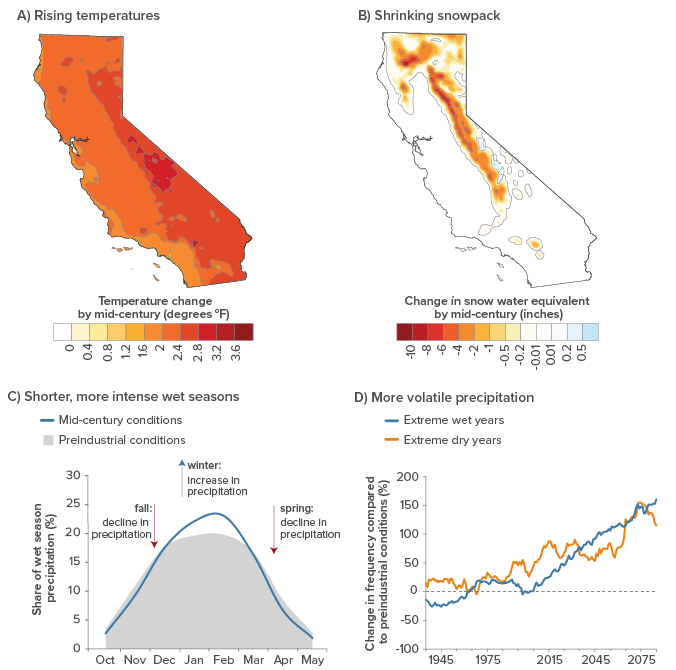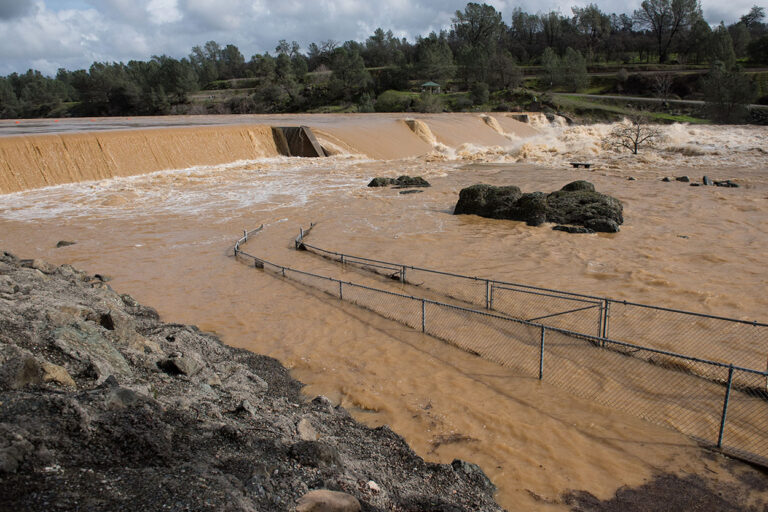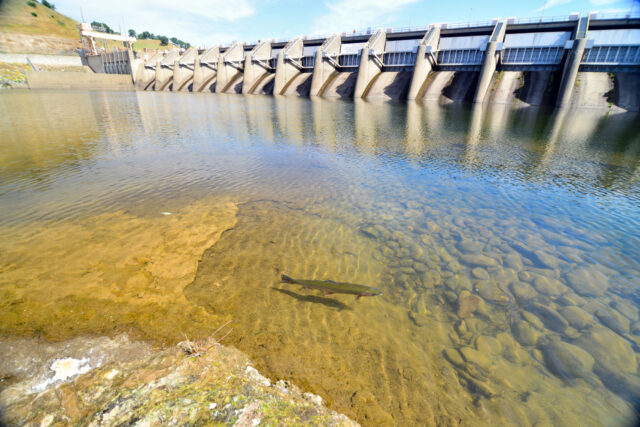- Managing water is at the forefront of climate change adaptation in California.
Five climate pressures—warming temperatures, shrinking snowpack, shorter and more intense wet seasons, more volatile precipitation, and rising seas—affect all aspects of water management. All of these pressures are already underway. For example, average temperatures in California have been rising for the past 40 years. Warming has complex and interrelated effects: it reduces the share of precipitation falling as snow, causes earlier snowpack melting and higher winter runoff, raises water temperatures, and amplifies the severity of droughts and floods. Warmer, more intense droughts—such as the one California experienced from 2012-16—increase pressure to draw down groundwater reserves. Warmer, more intense storms add stress to surface reservoirs, making it harder to meet sometimes competing objectives of storing water for droughts, safeguarding communities from harmful floods, and protecting freshwater ecosystems. Droughts and floods will become more intense over the next 20–50 years, bringing substantially greater risks. - The water grid is not prepared to handle a more volatile climate.
California’s vast and complex water storage and conveyance system is aging and outdated. Most of the nearly 1,500 dams and reservoirs were built more than 50 years ago, and designed for the hydrology of the past. The state’s groundwater basins have a much larger storage capacity than surface reservoirs, and are becoming much more important as a drought reserve. But they are underutilized. Above- and below-ground storage is linked by rivers and thousands of miles of canals and aqueducts—some of which have lost capacity to move water. Adapting to climate change will require a more robust, better-integrated water grid. - Strategic investments can reduce the impacts from more intense droughts and floods.
To increase groundwater storage, upgrading water conveyance infrastructure will be essential. Such investments can also make it easier to trade and share water—an important way to reduce the social, economic, and environmental costs of water scarcity. The 2017 Oroville Dam crisis highlighted the urgent need to improve dam safety to protect downstream residents against larger storms. Thousands of miles of aging, outdated levees will also need to be upgraded. Expanding the use of natural floodplains to capture and manage flood flows in some areas can reduce pressure on dams and levees, while benefiting ecosystems. - Rethinking infrastructure operations can also help reduce climate change impacts.
California will be able to store more water while managing flood risk if it manages surface and groundwater together to increase their combined potential. Moving some water from reservoirs into groundwater basins for dry years will be especially valuable. Promising efforts are underway in some watersheds—including
the Russian, American, Yuba, and Santa Ana Rivers—to update dam operations using advanced weather forecasting technology. More accurate forecasts can help managers decide the best course of action under rapidly changing conditions, such as when to release water to protect downstream areas from flooding, move water to groundwater basins, or keep water in reservoirs for later use. - Reliable sources of funding are needed to make the water system climate-ready.
Adaptation to more extreme droughts and floods will require well-defined, reliable sources of funding. Local revenue from water and sewer bills and local taxes accounts for roughly 85% of the more than $30 billion spent annually on the state’s water management. This means water users will need to cover the bulk of investments needed to repair and upgrade the water grid. But the state’s water system also has numerous “fiscal orphans”—areas where available funding is far below ongoing needs and there is no straightforward way to fill the gap. This includes several areas where climate pressures will increase vulnerability: freshwater ecosystems and headwater forests; and flood and stormwater management. Creative solutions to raise local revenues are needed—along with state support.
Climate change will affect temperatures, snowpack, and seasonal and yearly precipitation patterns

SOURCES: Panels A and B: Ullrich et al. (2018); panels C and D: Swain et al. (2018).
NOTES: Panel A shows average temperature increases relative to the 2012–16 drought for a similar drought in mid-century (2042–46). Panel B shows the decline in snowpack relative to 2017 for a similar wet year in mid-century (2047). The total statewide decline is 25%. Panel C shows how the distribution of precipitation during the wet season changes by mid-century relative to preindustrial (circa 1850) conditions. Fall and spring precipitation declines while winter precipitation increases. Panel D shows projected changes in the likelihood of a year being extremely wet (similar to 2017) or extremely dry (similar to 1977). Extreme wet years have a 1-in-25 chance of occurrence in any given year under preindustrial conditions; for extreme dry years, the chance of occurrence is 1-in-100. The likelihood—or percentage change in frequency—is increasing with the changing climate.
Topics
Drought Floods Freshwater Ecosystems Water Supply Water, Land & Air




